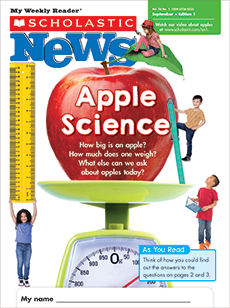Academic Standards
Learning Objective:
Children will describe how weasels change in autumn and understand why the animals must get ready for winter.
Science Focus:
animal adaptations
Page 4 Skill:
read a diagram
Vocabulary:
hunts, molt, camouflage
CCSS:
RI.1.1 ask and answer questions; RI.1.4 determine meaning of words; RI.1.5 text features; RI.1.10 read informational texts; RF.1.2 digraphs and vowels; W.1.3 sequence events; SL.1.1 participate in collaborative conversations
Watch the video
Watch the video
Build background knowledge about animal adaptations by watching “The Coolest Winter Adaptations.” When you’re done watching, ask the following question: What is one thing animals do to survive in the winter?
Preview new vocabulary words
Preview new vocabulary words
Project the online vocabulary slideshow and introduce this issue’s featured words.
Set a purpose for reading
Set a purpose for reading
- First read and discuss the cover. Can students predict the weasel’s trick? Then have students do a picture walk through the issue. What do they notice about the photographs of the weasel?
- Before turning to page 2, say, “As we read the article, think about how the weasel is changing over time. Why does it need to change?”
- As you read, pause after each box. Analyze each photograph and discuss how the weasel’s coat has changed in each box.
- Complete the page 4 activity as a group or individually.
- When you’re done reading, do the Dance Break!
- Reading Checkpoint (skill: reading comprehension)
- Weasel Sequencing (skill: sequencing)
- Color by Vowel (skill: vowel sounds)
Play the online game: Watch That Weasel!
(skill: digraphs)
Complete a hands-on activity: Weasel’s Spin Trick!
Kids create their own weasel trick while reviewing what they have learned about in the issue. (skills: fine-motor, writing)
Read a paired text: Once Upon a Weasel by Salvo Lavis
Once Upon a Weasel by Salvo Lavis is a funny picture book about a boy who adopts a weasel for a pet. Together, their imaginations run wild with dreams about space—until a reminder to be responsible brings them back to Earth!
